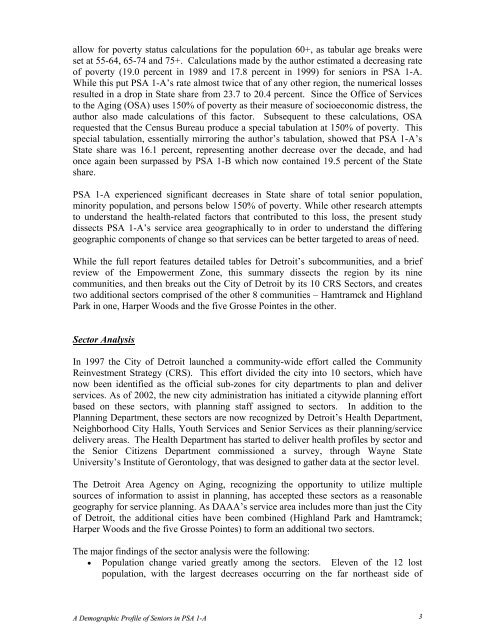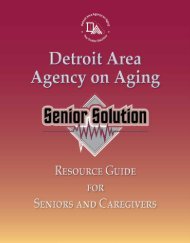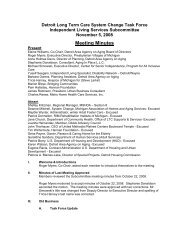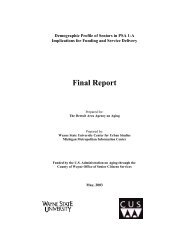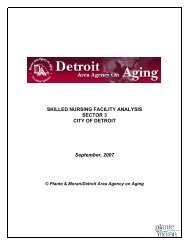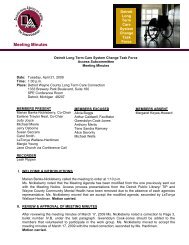Demographic Profile of Senior in Wayne County, Michigan
Demographic Profile of Senior in Wayne County, Michigan
Demographic Profile of Senior in Wayne County, Michigan
You also want an ePaper? Increase the reach of your titles
YUMPU automatically turns print PDFs into web optimized ePapers that Google loves.
allow for poverty status calculations for the population 60+, as tabular age breaks were<br />
set at 55-64, 65-74 and 75+. Calculations made by the author estimated a decreas<strong>in</strong>g rate<br />
<strong>of</strong> poverty (19.0 percent <strong>in</strong> 1989 and 17.8 percent <strong>in</strong> 1999) for seniors <strong>in</strong> PSA 1-A.<br />
While this put PSA 1-A’s rate almost twice that <strong>of</strong> any other region, the numerical losses<br />
resulted <strong>in</strong> a drop <strong>in</strong> State share from 23.7 to 20.4 percent. S<strong>in</strong>ce the Office <strong>of</strong> Services<br />
to the Ag<strong>in</strong>g (OSA) uses 150% <strong>of</strong> poverty as their measure <strong>of</strong> socioeconomic distress, the<br />
author also made calculations <strong>of</strong> this factor. Subsequent to these calculations, OSA<br />
requested that the Census Bureau produce a special tabulation at 150% <strong>of</strong> poverty. This<br />
special tabulation, essentially mirror<strong>in</strong>g the author’s tabulation, showed that PSA 1-A’s<br />
State share was 16.1 percent, represent<strong>in</strong>g another decrease over the decade, and had<br />
once aga<strong>in</strong> been surpassed by PSA 1-B which now conta<strong>in</strong>ed 19.5 percent <strong>of</strong> the State<br />
share.<br />
PSA 1-A experienced significant decreases <strong>in</strong> State share <strong>of</strong> total senior population,<br />
m<strong>in</strong>ority population, and persons below 150% <strong>of</strong> poverty. While other research attempts<br />
to understand the health-related factors that contributed to this loss, the present study<br />
dissects PSA 1-A’s service area geographically to <strong>in</strong> order to understand the differ<strong>in</strong>g<br />
geographic components <strong>of</strong> change so that services can be better targeted to areas <strong>of</strong> need.<br />
While the full report features detailed tables for Detroit’s subcommunities, and a brief<br />
review <strong>of</strong> the Empowerment Zone, this summary dissects the region by its n<strong>in</strong>e<br />
communities, and then breaks out the City <strong>of</strong> Detroit by its 10 CRS Sectors, and creates<br />
two additional sectors comprised <strong>of</strong> the other 8 communities – Hamtramck and Highland<br />
Park <strong>in</strong> one, Harper Woods and the five Grosse Po<strong>in</strong>tes <strong>in</strong> the other.<br />
Sector Analysis<br />
In 1997 the City <strong>of</strong> Detroit launched a community-wide effort called the Community<br />
Re<strong>in</strong>vestment Strategy (CRS). This effort divided the city <strong>in</strong>to 10 sectors, which have<br />
now been identified as the <strong>of</strong>ficial sub-zones for city departments to plan and deliver<br />
services. As <strong>of</strong> 2002, the new city adm<strong>in</strong>istration has <strong>in</strong>itiated a citywide plann<strong>in</strong>g effort<br />
based on these sectors, with plann<strong>in</strong>g staff assigned to sectors. In addition to the<br />
Plann<strong>in</strong>g Department, these sectors are now recognized by Detroit’s Health Department,<br />
Neighborhood City Halls, Youth Services and <strong>Senior</strong> Services as their plann<strong>in</strong>g/service<br />
delivery areas. The Health Department has started to deliver health pr<strong>of</strong>iles by sector and<br />
the <strong>Senior</strong> Citizens Department commissioned a survey, through <strong>Wayne</strong> State<br />
University’s Institute <strong>of</strong> Gerontology, that was designed to gather data at the sector level.<br />
The Detroit Area Agency on Ag<strong>in</strong>g, recogniz<strong>in</strong>g the opportunity to utilize multiple<br />
sources <strong>of</strong> <strong>in</strong>formation to assist <strong>in</strong> plann<strong>in</strong>g, has accepted these sectors as a reasonable<br />
geography for service plann<strong>in</strong>g. As DAAA’s service area <strong>in</strong>cludes more than just the City<br />
<strong>of</strong> Detroit, the additional cities have been comb<strong>in</strong>ed (Highland Park and Hamtramck;<br />
Harper Woods and the five Grosse Po<strong>in</strong>tes) to form an additional two sectors.<br />
The major f<strong>in</strong>d<strong>in</strong>gs <strong>of</strong> the sector analysis were the follow<strong>in</strong>g:<br />
• Population change varied greatly among the sectors. Eleven <strong>of</strong> the 12 lost<br />
population, with the largest decreases occurr<strong>in</strong>g on the far northeast side <strong>of</strong><br />
A <strong>Demographic</strong> <strong>Pr<strong>of</strong>ile</strong> <strong>of</strong> <strong>Senior</strong>s <strong>in</strong> PSA 1-A 3


